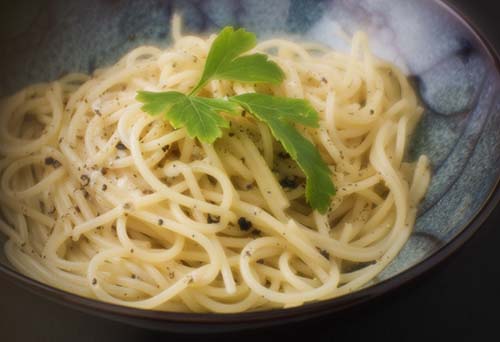Spaghetti Cacio e Pepe
7th September, 2010: Posted by G.L. Pease in easy, pasta

I’m sure I don’t have to say this, but I will anyway, just in case there is one single reader holding out for “convenience” at the expense of flavor and aroma: Throw away the jar (or, worse, the tin) of pre-ground pepper that’s been sitting on the shelf since great aunt Maude gave it to you as a house-warming present when you got your first apartment. It was as useless as a unicycle to an earthworm when it was “fresh,” and after it had seen the dawn of the new millennium, it became even more so. Bin it. Buy a decent pepper mill, some fresh peppercorns, and never, ever look back. Really.
Now that that’s sorted (and the single holdout has either stopped reading, or has gone on a quick spending expedition to get a shiny new Peugeot mill and a glass bottle of tellicherry peppercorns), we can talk about Spaghetti Cacio e Pepe (cheese and pepper), a classic Roman dish that’s almost as old as Rome itself, and universally loved. It’s quick, delicious, satisfying, and cheap as old chips to make. Go wild!
There are probably hundreds of recipes for this on the web, so why am I bothering with another? Because this one is true to its roots, containing only Pecorino Romano, pepper and spaghetti as its main ingredients—no oil—and because there are some little twists that make it even better.
The keys to this one are dry toasting the peppercorns, invigorating their already wonderful flavor with added depth, while taking off just a bit of their pungency (so you can use more!), and using the starchy pasta water, not oil, to help bind everything together. For the adventurous who aren’t bound by the purity of tradition, lemon zest and chopped parsley are included in the recipe for more layers of goodness. Give it a try both ways, and don’t forget to explore on your own.
Ingredients – Serves Four
- 1 pound of dry spaghetti
- 4 oz Pecorino Romano [1] (about 1 cup), shredded [2]
- 2 Tbsp peppercorns, toasted and crushed (see Method)
- 2 Tbsp lemon zest, finely minced (optional)
- 1/2 cup chopped flat-leaf parsley (optional)
Method – About 20 Minutes
This is a delightfully simple dish, but one that rewards careful attention during the assembly. Work quickly, but not hastily, or you’ll end up with a lumpy, clumpy mess. It’ll still taste good, but would you really want to serve it? When done carefully, this is wonderfully creamy and delicious.
- While preparing the rest of the ingredients, put a large pot with 12 cups of water and 2 Tbsp of salt over high heat, and bring to a boil.
- In a dry skillet over medium-high heat, toast the peppercorns, moving the pan constantly, until they are fragrant and just begin to pop and crackle, about two minutes. Remove from heat. Place peppercorns between two paper towels to keep the little rascals from getting away, and crush them with a rolling pin (or a wine bottle on its side) until the equivalent of a coarse grind. (Take a taste, now. Why wouldn’t you toast them first?) Don’t do this too early. Once the peppercorns are toasted and crushed, they’ll begin to give up their volatile oils quickly, losing flavor and aroma in the process. (And, have I mentioned before? Never use pre-ground pepper from a spice bottle. Ever.)
- Cook the spaghetti to just al dente, about 7 minutes. From this point, you’ll need to work quickly. Take the pot off the fire, and ladle some of the pasta water into a large bowl, preferably glass, to warm it and coat it with the starchy liquid. Then, pour the water back into the pasta pot.
- Transfer the spaghetti (with tongs), taking some of its liquid along for the ride. Gradually add the shredded cheese and toss with the spaghetti until evenly distributed and the pasta is well coated. If the sauce is too thick, add some of the pasta water, a tablespoon at a time; the starch in the water will help keep the cheese from clumping. Then, sprinkle with the pepper, and optionally the lemon zest and chopped parsley, adjust seasoning, give a final toss, and serve at once, enhanced with a few grinds of fresh pepper.
- A quick note on the cheese: You can certainly do this dish with Parmigiano Reggiano, or Grana Padano, but the Pecorino Romano, in addition to being authentic to the region, has a unique tang gives the dish its character.
- You can use grated Pecorino, but the finer it is, the more likely it will clump, rather than become creamy. Use a medium shred, instead, for best results.
2 Responses









October 7th, 2010 at 12:49 pm
The fastest, tastiest dish you will ever prepare!
The lemon zest is a must.
January 4th, 2011 at 9:55 am
Great take on one of my alltime favorite dishes. Perfection!
I was one of those who went on the spending expedition, I bought not one, but two Puegeot grinders for white pepper and Tellicherry black.
Thanks for the tip! Hands down the best pepper mills I’ve ever used!
Tommy